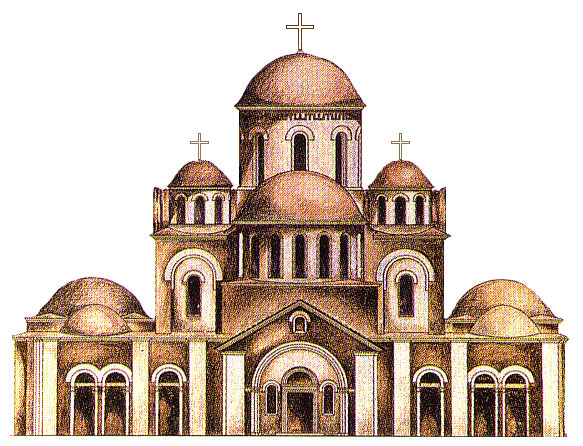In the last half of the tenth-century political ties between the Rus and the Byzantines were forged, and a conversion from pagan beliefs to Orthodoxy took place. In 988 Vladimir (aka Volodymyr, later “the Great”, “the First” and “Saint”; commemorated July 15th), Grand Duke (or Prince) of Kiev (Kyiv) concluded a treaty with Emperor Basil II, was baptized as Vasiliy (after St. Basil the Great, the patron saint of the emperor), and married the emperor’s sister Anna.
While Christianity had been making slow inroads in the region, closely following this event a radical conversion took place in Kiev. Vladimir called on his people to convert and be baptized, exclaiming: “If anyone does not go into the river tomorrow, be they rich or poor, beggar or slave, that one shall be my enemy.” In the words of Saint Hilarion, Metropolitan of Kiev (+ ca. 1053, commemorated October 21st in some traditions along with other St. Hilarions): “They demolished the pagan temples and built up churches, they destroyed the idols and produced holy icons, the demons have fled and the Cross has sanctified the cities.”
Soon after the baptism of his people, St. Vladimir ordered the first stone church to be built in Kiev (the other structures in the city being of wood). The location selected was the site of the martyrdom of the holy Varangian Martyrs (Theodore and his son John; commemorated July 12).
The necessary expertise (architects and stone masons) were sent from Constantinople, and construction took place ca. 989 to 996. The precious skull of St. Clement (+101; commemorated 24 Nov; skull now in the caves of the Kiev Pechersk Lavra) and relics of one of his disciples, St. Phoebus, were enshrined in a side-chapel built in St. Clement’s name. In addition, the remains of Vladimir’s grandmother, Princess (Saint) Olga (+969), were translated to this church. (Vladimir and his wife Anna were also later buried there.)
The magnificent temple was intended to become the cathedral for the new Metropolitan of Kiev and All Rus. The church was dedicated to the Dormition of the Theotokos, but was better known as theDesyatinnaya Tserkov (Tithe Church) because Vladimir endowed it with one tenth of his riches. The most ancient text of the grant reads in translation: “For I [Vladimir] do bestow on this church of the Holy Mother of God a tenth of all my principality, and also throughout all the Russian Land from all the princely jurisdiction a tithe of squirrel pelts, and from the merchant, a tithe of the week, and from households each year, a tenth of every herd and every livelihood, to the wondrous Mother of God and the wondrous Saviour.”
The church was consecrated on May 11th. The chronicles of the time preserved a prayer of St. Vladimir, with which he turned to the Almighty at the consecration of the church: “O Lord God, look down from Heaven and behold, and visit Your vineyard, which Your right hand has planted. And make these new people whom You have converted in heart and mind to know You, the True God. And look down upon this Your church, which Your unworthy servant has built in the name of the Mother Who gave birth to Thee, the Ever-Virgin Theotokos. And whoever prays in this church, let his prayer be heard, through the prayers of the All-Pure Mother of God.” After the cathedral church was consecrated to the Most Holy Theotokos, Vladimir also dedicated the capital city of the Rus (Kiev) to the Queen of Heaven. Thus by date and deed he provided the new Church a twofold sense of continuity, for under this day in the calendar is noted the churchly founding of Constantinople “dedicated by the holy emperor St. Constantine as the new capital of the Roman Empire, the city of Constantine is dedicated to the Most Holy Theotokos” (330). In addition, on this date, the church of St. Sophia in Kiev had also been previously consecrated (in the year 960 under St. Olga).








